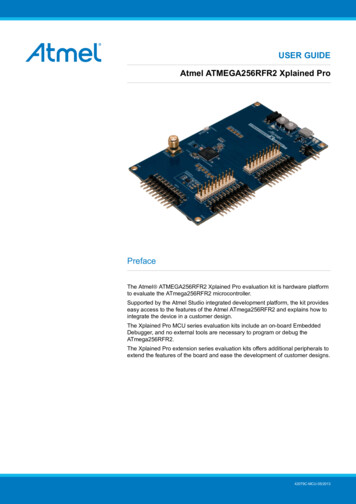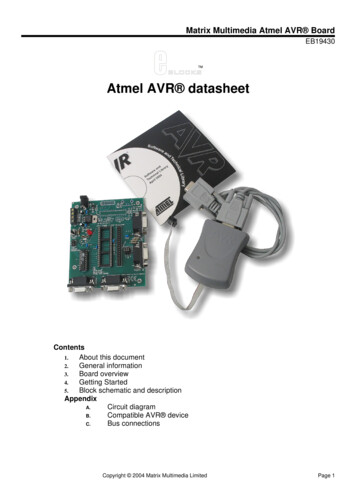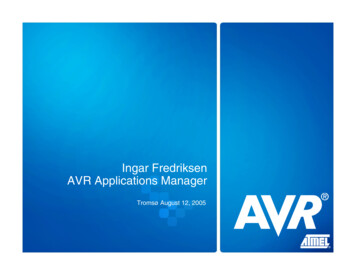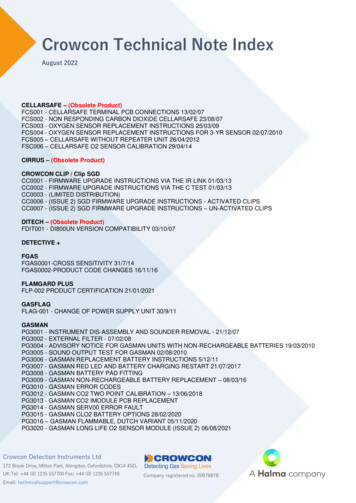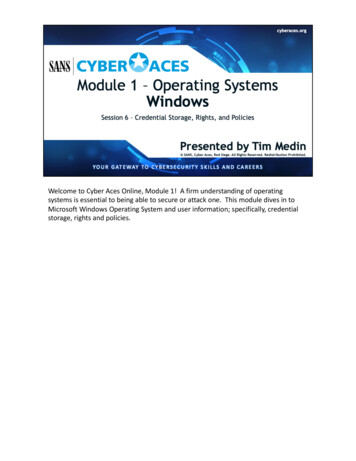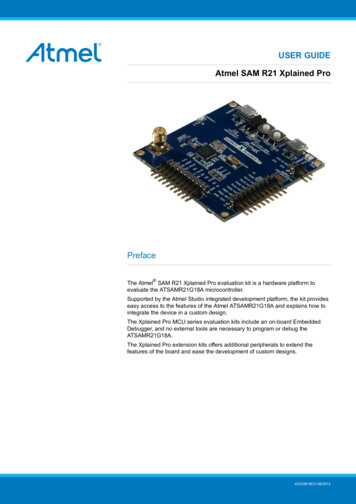
Transcription
USER GUIDEAtmel SAM R21 Xplained ProPreface The Atmel SAM R21 Xplained Pro evaluation kit is a hardware platform toevaluate the ATSAMR21G18A microcontroller.Supported by the Atmel Studio integrated development platform, the kit provideseasy access to the features of the Atmel ATSAMR21G18A and explains how tointegrate the device in a custom design.The Xplained Pro MCU series evaluation kits include an on-board EmbeddedDebugger, and no external tools are necessary to program or debug theATSAMR21G18A.The Xplained Pro extension kits offers additional peripherals to extend thefeatures of the board and ease the development of custom designs.42243B-MCU-06/2014
Table of ContentsPreface . 11. Introduction . 31.1.1.2.Features . 3Kit Overview . 32. Getting Started . 52.1.2.2.2.3.Quick-start . 5Connecting the Kit . 5Design Documentation and Related Links . 53. Xplained Pro . 63.1.3.2.3.3.3.4.Embedded Debugger .Hardware Identification System .Power Supply .3.3.1.Measuring SAM R21 Power Consumption .Standard Headers and Connectors .3.4.1.Xplained Pro Standard Extension Header .3.4.2.Xplained Pro Power Header .66777784. Hardware User Guide . 104.1.4.2.4.3.4.4.Connectors .4.1.1.I/O Extension Headers .4.1.2.Other Headers and Connectors .Peripherals .4.2.1.Crystal .4.2.2.Mechanical Buttons .4.2.3.LED .4.2.4.USB .4.2.5.RF .1.8V Operation .Embedded Debugger Implementation .4.4.1.Serial Wire Debug .4.4.2.Virtual COM port .4.4.3.Atmel Data Gateway Interface .10101111111212121213141515155. Kit Specific Data . 166. Agency Certification . 176.1.6.2.6.3.6.4.United States (FCC) .European Union (ETSI) .Canada (IC) .List of Antennas Tested With This Product .171718187. Hardware Revision History and Known Issues . 197.1.7.2.Identifying Product ID and Revision . 19Revision 3 . 198. Document revision history . 209. Evaluation Board/Kit Important Notice . 21Atmel SAM R21 Xplained Pro [USER GUIDE]42243B-MCU-06/20142
1.Introduction1.1Features Atmel ATSAMR21G18A microcontroller Embedded debugger (EDBG) 1.2 USB interface Programming and debugging on board SAM R21 through Serial Wire Debug (SWD) Virtual COM-port interface to target via UART Atmel Data Gateway Interface (DGI) to target via SPI and TWI Four GPIOs connected to target for code instrumentationDigital I/O Two mechanical buttons (user and reset button) One user LED Two extension headersAntenna One ceramic chip antenna (2450AT18D0100) One SMA connector for external antennaThree possible power sources External power Embedded debugger USB Target USB 32kHz crystal 16MHz crystal USB interface, deviceKit OverviewThe Atmel SAM R21 Xplained Pro evaluation kit is a hardware platform to evaluate the AtmelATSAMR21G18A.The kit offers a set of features that enables the ATSAMR21G18A user to get started using theATSAMR21G18A peripherals right away and to get an understanding of how to integrate the device in theirown design.Atmel SAM R21 Xplained Pro [USER GUIDE]42243B-MCU-06/20143
Figure 1-1. SAM R21 Xplained Pro Evaluation Kit OverviewAtmel SAM R21 Xplained Pro [USER GUIDE]42243B-MCU-06/20144
2.Getting Started2.1Quick-startThree steps to start exploring the Atmel Xplained Pro Platform2.21 Download and install Atmel Studio Launch Atmel Studio Connect a Micro-B cable to the DEBUG USB portConnecting the KitWhen connecting Atmel SAM R21 Xplained Pro to your computer for the first time, the operating system will do a driver software installation. The driver file supports both 32-bit and 64-bit versions of Microsoft WindowsXP and Windows 7.Once connected the green power LED will be lit and Atmel Studio will autodetect which Xplained Proevaluation- and extension kit(s) that's connected. You'll be presented with relevant information like datasheetsand kit documentation. You also have the option to launch Atmel Software Framework (ASF) exampleapplications. The target device is programmed and debugged by the on-board Embedded Debugger and2no external programmer or debugger tool is needed. Refer to the Atmel Studio user guide for informationregarding how to compile and program the kit.2.3Design Documentation and Related LinksThe following list contains links to the most relevant documents and software for SAM R21 Xplained Pro.31.Xplained Pro products - Atmel Xplained Pro is a series of small-sized and easy-to-use evaluation kitsfor Atmel AVR 8- and 32-bit microcontrollers. It consists of a series of low cost MCU boards for evaluationand demonstration of features and capabilities of different MCU families.2.SAM R21 Xplained Pro User Guide - PDF version of this User Guide.3.SAM R21 Xplained Pro Design Documentation - Package containing schematics, BOM, assemblydrawings, 3D plots, layer plots etc.4.EDBG User Guide - User guide containing more information about the onboard Embedded Debugger.5.Atmel Studio - Free Atmel IDE for development of C/C and assembler code for Atmelmicrocontrollers.6.IAR Embedded Workbenchfor ARM . This is a commercial C/C compiler that is available for ARM.There is a 30 day evaluation version as well as a code size limited kick-start version available from theirwebsite. The code size limit is 16KB for devices with M0, M0 and M1 cores and 32KB for devices withother cores.7.Atmel sample store - Atmel sample store where you can order samples of devices.4567 8 ained-Pro 2243-SAMR21-Xplained-Pro 2096-Microcontrollers-Embedded-Debugger mel SAM R21 Xplained Pro [USER GUIDE]42243B-MCU-06/20145
3.Xplained ProXplained Pro is an evaluation platform that provides the full Atmel microcontroller experience. The platformconsists of a series of Microcontroller (MCU) boards and extension boards that are integrated with AtmelStudio, have Atmel Software Framework (ASF) drivers and demo code, support data streaming and more.Xplained Pro MCU boards support a wide range of Xplained Pro extension boards that are connected througha set of standardized headers and connectors. Each extension board has an identification (ID) chip to uniquelyidentify which boards are mounted on a Xplained Pro MCU board. This information is used to present relevantuser guides, application notes, datasheets and example code through Atmel Studio. Available Xplained Pro1MCU and extension boards can be purchased in the Atmel Web Store .3.1Embedded DebuggerThe SAM R21 Xplained Pro contains the Atmel Embedded Debugger (EDBG) for on-board debugging. TheEDBG is a composite USB device of three interfaces; a debugger, Virtual COM Port and Data GatewayInterface (DGI).In conjunction with Atmel Studio, the EDBG debugger interface can program and debug the ATSAMR21G18A.On the SAM R21 Xplained Pro, the SWD interface is connected between the EDBG and the ATSAMR21G18A.The Virtual COM Port is connected to a UART port on the ATSAMR21G18A (see section “Embedded DebuggerImplementation” on page 14 for pinout), and provides an easy way to communicate with the targetapplication through simple terminal software. It offers variable baud rate, parity and stop bit settings. Note thatthe settings on the target device UART must match the settings given in the terminal software.The DGI consists of several physical data interfaces for communication with the host computer. See section“Embedded Debugger Implementation” on page 14 for available interfaces and pinout. Communicationover the interfaces are bidirectional. It can be used to send events and values from the ATSAMR21G18A, oras a generic printf-style data channel. Traffic over the interfaces can be timestamped on the EDBG for moreaccurate tracing of events. Note that timestamping imposes an overhead that reduces maximal throughput. TheDGI uses a proprietary protocol, and is thus only compatible with Atmel Studio.The EDBG controls two LEDs on SAM R21 Xplained Pro, a power LED and a status LED. Table 3-1, “EDBGLED Control” on page 6 shows how the LEDs are controlled in different operation modes.Table 3-1. EDBG LED ControlOperation modePower LEDStatus LEDNormal operationPower LED is lit when power isapplied to the board.Activity indicator, LED flashesevery time something happens onthe EDBG.Bootloader mode (idle)The power LED and the status LED blinks simultaneously.Bootloader mode (firmwareupgrade)The power LED and the status LED blinks in an alternating pattern.2For further documentation on the EDBG, see the EDBG User Guide .3.2Hardware Identification SystemAll Xplained Pro compatible extension boards have an Atmel ATSHA204 CryptoAuthentication chip mounted.This chip contains information that identifies the extension with its name and some extra data. When anXplained Pro extension board is connected to an Xplained Pro MCU board the information is read and sentto Atmel Studio. The Atmel Kits extension, installed with Atmel Studio, will give relevant information, codeexamples and links to relevant documents. Table 3-2, “Xplained Pro ID Chip Content” on page 6 shows thedata fields stored in the ID chip with example content.Table 3-2. Xplained Pro ID Chip Content12Data FieldData TypeExample ContentManufacturerASCII stringAtmel’\0’Product NameASCII stringSegment LCD1 Xplained Pro’\0’Product RevisionASCII string02’\0’Product Serial NumberASCII 42096-Microcontrollers-Embedded-Debugger User-Guide.pdfAtmel SAM R21 Xplained Pro [USER GUIDE]42243B-MCU-06/20146
3.3Data FieldData TypeExample ContentMinimum Voltage [mV]uint16 t3000Maximum Voltage [mV]uint16 t3600Maximum Current [mA]uint16 t30Power SupplyThe SAM R21 Xplained Pro kit can be powered either by USB or by an external power source through the 4pin power header, marked PWR. This connector is described in “Xplained Pro Power Header” on page 8.The available power sources and specifications are listed in Table 3-3, “Power Sources for SAM R21 XplainedPro” on page 7.Table 3-3. Power Sources for SAM R21 Xplained ProPower inputVoltage requirementsCurrent requirementsConnector markingExternal power5V 2 % ( 100mV) forUSB host operation.Recommendedminimum is 1A tobe able to provideenough current forconnected USBdevices and the boarditself. Recommendedmaximum is 2A dueto the input protectionmaximum currentspecification.PWR4.3V to 5.5V if USB hostoperation is not requiredEmbedded debuggerUSB4.4V to 5.25V(according to USB spec)500mA (according toUSB spec)EDBG USBTarget USB4.4V to 5.25V(according to USB spec)500mA (according toUSB spec)TARGET USBThe kit will automatically detect which power sources are available and choose which one to use according tothe following priority:Note3.3.11.External power.2.Embedded debugger USB.3.Target USB.External power is required when the 500mA through the USB connector is not enough to power aconnected USB device in a USB host application.Measuring SAM R21 Power ConsumptionAs part of an evaluation of the SAM R21 it can be of interest to measure its power consumption. Because thedevice has a separate power plane (VCC MCU P3V3) on this board it is possible to measure the currentconsumption by measuring the current that is flowing into this plane. The VCC MCU P3V3 plane is connectedvia a jumper to the main power plane (VCC TARGET P3V3) and by replacing the jumper with an ammeter it ispossible to determine the current consumption. To locate the current measurement header, refer to Figure 1-1,“SAM R21 Xplained Pro Evaluation Kit Overview” on page 4.WarningDo not power the board without having the jumper or an ammeter mounted. This can cause theSAM R21 to be powered through its I/O pins and cause undefined operation of the device.3.4Standard Headers and Connectors3.4.1Xplained Pro Standard Extension HeaderAll Xplained Pro kits have one or more dual row, 20-pin, 100mil extension headers. Xplained Pro MCU boardshave male headers while Xplained Pro extensions have their female counterparts. Note that all pins are notAtmel SAM R21 Xplained Pro [USER GUIDE]42243B-MCU-06/20147
always connected. However, all the connected pins follow the defined pin-out described in Table 3-4, “XplainedPro Extension Header” on page 8. The extension headers can be used to connect a wide variety ofXplained Pro extensions to Xplained Pro MCU boards and to access the pins of the target MCU on XplainedPro MCU board directly.Table 3-4. Xplained Pro Extension Header3.4.2Pin numberNameDescription1IDCommunication line to the ID chip on extension board.2GNDGround.3ADC( )Analog to digital converter , alternatively positive part ofdifferential ADC.4ADC(-)Analog to digital converter , alternatively negative part ofdifferential ADC.5GPIO1General purpose I/O.6GPIO2General purpose I/O.7PWM( )Pulse width modulation , alternatively positive part ofdifferential PWM.8PWM(-)Pulse width modulation , alternatively positive part ofdifferential PWM.9IRQ/GPIOInterrupt request line and/or general purpose I/O.10SPI SS B/GPIOSlave select for SPI and/or general purpose I/O.11TWI SDAData line for two-wire interface. Always implemented, bustype.12TWI SCLClock line for two-wire interface. Always implemented, bustype.13USART RXReceiver line of Universal Synchronous and Asynchronousserial Receiver and Transmitter.14USART TXTransmitter line of Universal Synchronous andAsynchronous serial Receiver and Transmitter.15SPI SS ASlave select for SPI. Should be unique if possible.16SPI MOSIMaster out slave in line of Serial peripheral interface. Alwaysimplemented, bus type.17SPI MISOMaster in slave out line of Serial peripheral interface. Alwaysimplemented, bus type.18SPI SCKClock for Serial peripheral interface. Always implemented,bus type.19GNDGround.20VCCPower for extension board.Xplained Pro Power HeaderThe power header can be used to connect external power to the SAM R21 Xplained Pro kit. The kit willautomatically detect and switch to the external power if supplied. The power header can also be used as supplyfor external peripherals or extension boards. Care must be taken not to exceed the total current limitationof the on-board regulator for the 3.3V regulated output. To locate the current measurement header, refer toFigure 1-1, “SAM R21 Xplained Pro Evaluation Kit Overview” on page 4Table 3-5. Power Header PWRPin number PWR headerPin nameDescription1VEXT P5V0External 5V input2GNDGround3VCC P5V0Unregulated 5V (output, derivedfrom one of the input sources)Atmel SAM R21 Xplained Pro [USER GUIDE]42243B-MCU-06/20148
NotePin number PWR headerPin nameDescription4VCC P3V3Regulated 3.3V (output, used asmain power for the kit)If the board is powered from a battery source it is recommended to use the PWR header. If thereis a power source connected to EDBG USB, the EDBG is activated and it will consume morepower.Atmel SAM R21 Xplained Pro [USER GUIDE]42243B-MCU-06/20149
4.Hardware User Guide4.1ConnectorsThis chapter describes the implementation of the relevant connectors and headers on SAM R21 Xplained Proand their connection to the ATSAMR21G18A. The tables of connections in this chapter also describes whichsignals are shared between the headers and on-board functionality.4.1.1I/O Extension HeadersThe SAM R21 Xplained Pro headers EXT1 and EXT3 offer access to the I/O of the microcontroller in orderto expand the board e.g. by connecting extensions to the board. These headers all comply with the standardextension header specified in Xplained Pro Standard Extension Header on page 7. All headers have a pitch of2.54mm.Table 4-1. Extension Header EXT1Pin on EXT1SAM R21 pinFunctionShared functionality1 [ID]-Communication line to ID chipon extension board2 [GND]-GND3 [ADC( )]PA06AIN[6]4 [ADC(-)]PA07AIN[7]5 [GPIO1]PA13GPIO6 [GPIO2]PA28GPIO7 [PWM( )]PA18TCC0 / WO[2]8 [PWM(-)]PA19TCC0 / WO[3]9 [IRQ/GPIO]PA22EXTINT[6]10 [SPI SS B/GPIO]PA23GPIO11 [TWI SDA]PA16SERCOM1 PAD[0] I²C SDAEXT3 and EDBG12 [TWI SCL]PA17SERCOM1 PAD[1] I²C SCLEXT3 and EDBG13 [USART RX]PA05SERCOM0 PAD[1] UART RXEDBG14 [USART TX]PA04SERCOM0 PAD[0] UART TXEDBG15 [SPI SS A]PB03SERCOM5 PAD[1] SPI SS16 [SPI MOSI]PB22SERCOM5 PAD[2] SPI MOSIEXT3 and EDBG17 [SPI MISO]PB02SERCOM5 PAD[0] SPI MISOEXT3 and EDBG18 [SPI SCK]PB23SERCOM5 PAD[3] SPI SCKEXT3 and EDBG19 [GND]-GND20 [VCC]-VCCTable 4-2. Extension Header EXT3Pin on EXT3SAM R21 pinFunctionShared functionality1 [ID]-Communication line to ID chipon extension board2 [GND]-GND3 [ADC( )]--4 [ADC(-)]--5 [GPIO1]PA15GPIO6 [GPIO2]-7 [PWM( )]-8 [PWM(-)]-9 [IRQ/GPIO]-Atmel SAM R21 Xplained Pro [USER GUIDE]42243B-MCU-06/201410
4.1.2Pin on EXT3SAM R21 pinFunctionShared functionality10 [SPI SS B/GPIO]PA08GPIOEDBG11 [TWI SDA]PA16SERCOM1 PAD[0] I²C SDAEXT1 and EDBG12 [TWI SCL]PA17SERCOM1 PAD[1] I²C SCLEXT1 and EDBG13 [USART RX]--14 [USART TX]--15 [SPI SS A]PA14GPIOEDBG16 [SPI MOSI]PB22SERCOM5 PAD[2] SPI MOSIEXT1 and EDBG17 [SPI MISO]PB02SERCOM5 PAD[0] SPI MISOEXT1 and EDBG18 [SPI SCK]PB23SERCOM5 PAD[3] SPI SCKEXT1 and EDBG19 [GND]-GND20 [VCC]-VCCOther Headers and ConnectorsThere are two headers that are not mounted on the kit from production. These headers contains signals thatare otherwise not easily accecible on the kit.4.1.2.1Altnernate Signals HeaderThe alternate signals header is marked with "Alternate" in silkscreen of the kit, the signals provided here areotherwise hard to do measurements on.Table 4-3. Alternate Signals Header4.1.2.2Pin on headerPin on SAM R21Function1PA09RFCTRL1, negative antenna switch control signal2PA12RFCTRL2, positive antenna switch control signal3PA27GPIO, chip select on the EDBG DGI SPI busCortex Debug ConnectorThe Cortex debug connector is provided to enable external debuggers to be connected to theATSAMR21G18A. The footpring is made for a 2x5 50mil connector and the pinout is shown in Table 4-4,“Cortex Debug Connector” on page 11. This header should only be used when the EDBG is disconnectedfrom the target, for more information see “1.8V Operation” on page 13.Table 4-4. Cortex Debug ConnectorPin on connectorConnectedFunction1VCC TargetVoltage reference2PA31 SWDIODebug data3GNDGND4PA30 SWCLKDebug clock5GNDGND6NC-7NC-8NC-9GNDGND detect10RESETNTarget reset4.2Peripherals4.2.1CrystalThe SAM R21 Xplained Pro kit contains one crystals that can be used as clock source for the SAM R21 device.The crystal has a cut-strap next to it that can be used to measure the oscillator safety factor. This is done byAtmel SAM R21 Xplained Pro [USER GUIDE]42243B-MCU-06/201411
cutting the strap and adding a resistor across the strap. More information about oscillator allowance and safety1factor can be found in appnote AVR4100 .NoteThe 16MHz crystal is connected directly to the RF die inside the SAM R21. The clock signalgenerated by the crystal is routed from the CLKM pin on the RF die to a GCLK IO pin on themicrocontroller. For more information on how the RF die is connected to the microcontroller andhow to configure the CLKM pin see the SAM R21 datasheet.Table 4-5. External 32.768kHz CrystalPin on SAM R21FunctionPA00XIN32PA01XOUT32Table 4-6. External 16MHz Crystal4.2.2Pin on SAM R21FunctionXTAL1XINXTAL2XOUTMechanical ButtonsSAM R21 Xplained Pro contains two mechanical buttons. One button is the RESET button connected to theSAM R21 reset line and the other is a generic user configurable button. When a button is pressed it will drivethe I/O line to GND.Table 4-7. Mechanical Buttons4.2.3Pin on SAM R21Silkscreen textRESETNRESETPA28SW0LEDThere is one yellow LED available on the SAM R21 Xplained Pro board that can be turned on and off. The LEDcan be activated by driving the connected I/O line to GND.Table 4-8. LED Connections4.2.4Pin on SAM R21LEDPA19Yellow LED0USBThe SAM R21 Xplained Pro has a Micro-USB receptable for use with the SAM R21 USB module. To be able todetect when a USB cable is connected, a GPIO / ADC is used to detect the VBUS voltage on the connector.Table 4-9. USB Connections4.2.5Pin on SAM R21USBPA07VBUS DetectionPA24USB D-PA25USB D RFThe main feature of SAM R21 Xplained Pro is to show the RF capability of the ATSAMR21G18A device.This device has bidirectional 100ohm differential antenna pins, which are fed through a balun tmel SAM R21 Xplained Pro [USER GUIDE]42243B-MCU-06/201412
2Technology, 2450BM15A0015 ) to create a single 50ohm unbalanced output/input. This kit has a passive3analog RF switch (Skyworks Solutions Inc, AS222-92LF ) connected to the unbalanced output of thebalun. The switch is driven by the RFCTRL1 and RFCTRL2 pins of the ATSAMR21G18A which featureAntenna Diversity to enable the device to automatically select the best signal from two antennas (can also beselected manually). The output of the switch is connected to a ceramic chip antenna (Johanson Technology,42540AT18D0100 ) and a SMA connector for external antennas.Table 4-10. RF Connections4.3Pin on SAM R21RFShared functionalityRFPRF balanced output (positive)RFNRF balanced output (negative)PA09 / RFCTRL1RF switch control signal(negative)EDBGPA12 / RFCTRL2RF switch control signal (positive)EDBG1.8V OperationThe SAM R21 Xplained Pro board is operated at 3.3V by default, but it also has the possibility of runningat lower voltages from an external supply. The EDBG is designed to run from a 3.3V supply and won'twork on other voltages, therefore all connections from the EDBG and the on board 3.3V regulator to theATSAMR21G18A have to be removed. Figure 4-1, “1.8V Operation Modifications” on page 14 shows allcomponents that have to be removed for 1.8V operation.When the components are removed the kit can be supplied with a desired voltage through the pins marked 3V3(pin four) and GND (pin two) on the power header described in “Xplained Pro Power Header” on page 8.To program and debug the ATSAMR21G18A a 2x5 50mil header has to be mounted above EXT1 as shown inFigure 1-1, “SAM R21 Xplained Pro Evaluation Kit Overview” on page ntenna 2450AT18D0100 v3.pdf3Atmel SAM R21 Xplained Pro [USER GUIDE]42243B-MCU-06/201413
NoteOperating the SAM R21 Xplained Pro on other voltages than 3.3V requires physical modificationson the kit using a soldering iron and an external debugger for programming the ATSAMR21G18A.The on board LED is selected for 3.3V operation, the light level at 1.8V opeartion is very low. Toincrease the emitted light level the value of the series resistor can be lowered.The EDBG functionality can be restored by re-soldering the removed components, they are all 0ohm resistors.ImportantThe voltage supplied through the power header is applied directly to the ATSAMR21G18A andthe extension headers, applying a voltage greater than 3.3V may damage the board permanently.Figure 4-1. 1.8V Operation Modifications4.4Embedded Debugger ImplementationSAM R21 Xplained Pro contains an Embedded Debugger (EDBG) that can be used to program and debug theATSAMR21G18A using Serial Wire Debug (SWD). The Embedded Debugger also include a Virtual Com portinterface over UART, an Atmel Data Gateway Interface over SPI and TWI and it monitors four of the SAM R21GPIOs. Atmel Studio can be used as a front end for the Embedded Debugger.Atmel SAM R21 Xplained Pro [USER GUIDE]42243B-MCU-06/201414
4.4.1Serial Wire DebugThe Serial Wire Debug (SWD) use two pins to communicate with the target. For further information on how touse the programming and debugging capabilities of the EDBG, see “Embedded Debugger” on page 6.Table 4-11. SWD Connections4.4.2Pin on SAM R21FunctionPA30SWD clockPA31SWD dataVirtual COM portThe Embedded Debugger acts as a Virtual Com Port gateway by using one of the ATSAMR21G18A UARTs.For further information on how to use the Virtual COM port see “Embedded Debugger” on page 6.Table 4-12. Virtual COM Port Connections4.4.3Pin on SAM R21FunctionPA04SERCOM0 PAD[0] UART TXD (SAM R21 TX line)PA05SERCOM1 PAD[1] UART RXD (SAM R21 RX line)Atmel Data Gateway InterfaceThe Embedded Debugger features an Atmel Data Gateway Interface (DGI) by using either a SPI or I²C port.The DGI can be used to send a variety of data from the SAM R21 to the host PC. For further information onhow to use the DGI interface see “Embedded Debugger” on page 6.Table 4-13. DGI Interface Connections When Using SPIPin on SAM R21FunctionPA27GPIO SPI SS (Slave select) (SAM R21 is Master)PB02SERCOM5 PAD[0] SPI MISO (Master In, Slave Out)PB22SERCOM5 PAD[2] SPI MOSI (Master Out, Slave in)PB23SERCOM5 PAD[3] SPI SCK (Clock Out)Table 4-14. DGI Interface Connections When Using I²CPin on SAM R21FunctionPA16SERCOM1 PAD[0] I²C SDA (Data line)PA17SERCOM1 PAD[1] I²C SCL (Clock line)Four GPIO lines are connected to the Embedded Debugger. The EDBG can monitor these lines and timestamp pin value changes. This makes it possible to accurately time stamp events in the SAM R21 applicationcode. For further information on how to configure and use the GPIO monitoring features see “EmbeddedDebugger” on page 6.Table 4-15. GPIO Lines Connected to the EDBGPin on SAM el SAM R21 Xplained Pro [USER GUIDE]42243B-MCU-06/201415
5.Kit Specific DataOne of the user pages in the EDBG is programmed with data specific to the SAM R21 Xplained Pro. The data2can be read through the I C interface connected to the EDBG, for detailed information see the EDBG User1Guide . All data is stored as little endian.Table 5-1. MAC64Register, Offset: 0x001NameDescriptionSize [bits]MAC64MAC64 Address rocontrollers-Embedded-Debugger User-Guide.pdfAtmel SAM R21 Xplained Pro [USER GUIDE]42243B-MCU-06/201416
6.Agency Certification6.1United States (FCC)This equipment complies with Part 15 of the FCC rules and regulations. To fulfill FCC Certificationrequirements, an OEM manufacturer must comply with the following regulations:1.ImportantThis equipment (SAM R21 Xplained Pro) is for use for evaluation purposes only and must not beincorporated into any other device or system.This equipment complies with Part 15 of the FCC Rules. Operation is subject to the following twoconditions: (1) this device may not cause harmful interference, and (2) this device must acceptany interference received, including interference that may cause undesired operation (FCC15.19).The internal / external antenna(s) used for this mobile transmitter must provide a separation distance of atleast 20cm from all persons and must not be colocated or operating in conjunction with any other antenna ortransmitter.Installers must be provided with antenna installation instructions and transmitter operating conditions forsatisfying RF exposure compliance. This device is approved as a mobile device with respect to RF exposurecompliance, and may only be marketed to OEM installers. Use in portable exposure conditions (FCC 2.1093)requires separate equipment authorization.ImportantModifications not expressly approved by this company could void the user's authority to operatethis equipment (FCC section 15.21).ImportantThis equipment has been tested and found to comply with the limits for a Class A digital device,pursuant to Part 15 of the FCC Rules. These limits are designed to provide reasonable protectionagainst harmful interference when the equipment is operated in a commercial environment.This equipment generates, use
The Atmel SAM R21 Xplained Pro evaluation kit is a hardware platform to evaluate the Atmel ATSAMR21G18A. The kit offers a set of features that enables the ATSAMR21G18A user to get started using the ATSAMR21G18A peripherals right away and to get an understanding of how to integrate the device in their own design.
